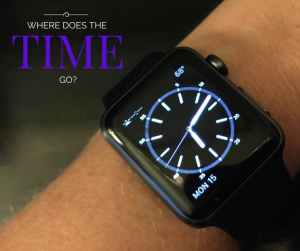 Object: Understanding how my time is spent, to gain a big picture view (and if needed, adjust) my work-habits.
Object: Understanding how my time is spent, to gain a big picture view (and if needed, adjust) my work-habits.What Didn’t Work: Trying to put things on the calendar and stick to strict pre-determined time slots. Hopping from one project to another in response to whatever pinged at the moment. Simply hoping I was getting to all of my projects. Only vaguely being able to answer the question: so how long did it take to… (fill in the blank)?
My Aha! Moment: I was listening to Amy Porterfield’s podcast (Episode 47). In this interesting interview about mindset she interviewed Todd Herman. Todd suggested keeping a chart of $10 work, $100 work, and $1000 work for a week. The challenge was to notice each task you did and record it into one of those columns. I loved the idea of the activity, but wasn’t yet in the place where I could afford to outsource anything. Outsourcing is the ultimate goal of the activity— acknowledging that when you’re the content-maker, creating your content is your greatest contribution, and that perhaps you oughtn’t to be coding HTML so your website works.
I remember thinking, “But I don’t even know which projects I’m spending my time on, let alone the amount of money I’d someday be able to pay someone to do the tasks!” For me, the first problem to tackle was “which project does this task fit into?” I needed to better understand where my hours were going before I could determine where any time-leaks might be. Maybe I was spending 20 hours a week on a project, but on all of the wrong parts of the project. Or maybe I was ignoring certain projects for too long, only returning to them after they had turned into raging problem-fires. I needed a way to track my time.
Enter the Timely app, a very nice-to-look-at visual time-tracking tool.
How I Play:
- I’ve connected the Timely app with my main calendar, so the app knows what I’m supposed to spend my time on.
- I can create a new task with just a couple easy clicks on my phone or desktop, and start a timer or enter time spent manually.
- I use big categories, such as “admin” or “planning,” and sometimes add a few notes. The main thing for me is to see what I’m doing in broad strokes.
Player’s Notes:
- If my day gets busy and I forget to record some time spent, I record estimates at the end of the day, when I still remember.
- Timely has saved me so much time going back and trying to remember, particularly with invoices. Often, scheduling and hourly billing shifts due to various factors, so having a day-by-day record what actually happened is very helpful.
Take it to the Next Level:
- Review how your time was spent every couple weeks with the Timely reports. Are there trends that point to problems? If so, how can you turn that problem into a question, for which you can then seek a solution?

